Report: Supporting Independent Living with Technology in Healthcare
VerifiedAdded on 2020/10/05
|11
|4067
|113
Report
AI Summary
This report delves into the application of technology to support independent living, examining its various facets within health and social care. The report starts by outlining the use of technology, including specific tools and techniques employed to improve patient care and promote independent lifestyles. It addresses the barriers to technology adoption, such as cost, digital literacy, and ethical concerns, and highlights the benefits for both service users and healthcare organizations, including improved efficiency and patient outcomes. The report explores health and safety considerations, emphasizing the importance of policies and training, and discusses ethical considerations such as patient rights and confidentiality. Furthermore, it analyzes the impact of recent technological developments on health and social care, including the use of personal digital assistants and assistive technologies. The report also provides recommendations for technology use based on the needs of individuals requiring support, and concludes with an assessment of the overall usefulness of technology in enhancing the lives of users of health and social care services. The report uses case studies to illustrate the practical application of these concepts.

Supporting Independent Living
Table of Contents
Table of Contents
Paraphrase This Document
Need a fresh take? Get an instant paraphrase of this document with our AI Paraphraser
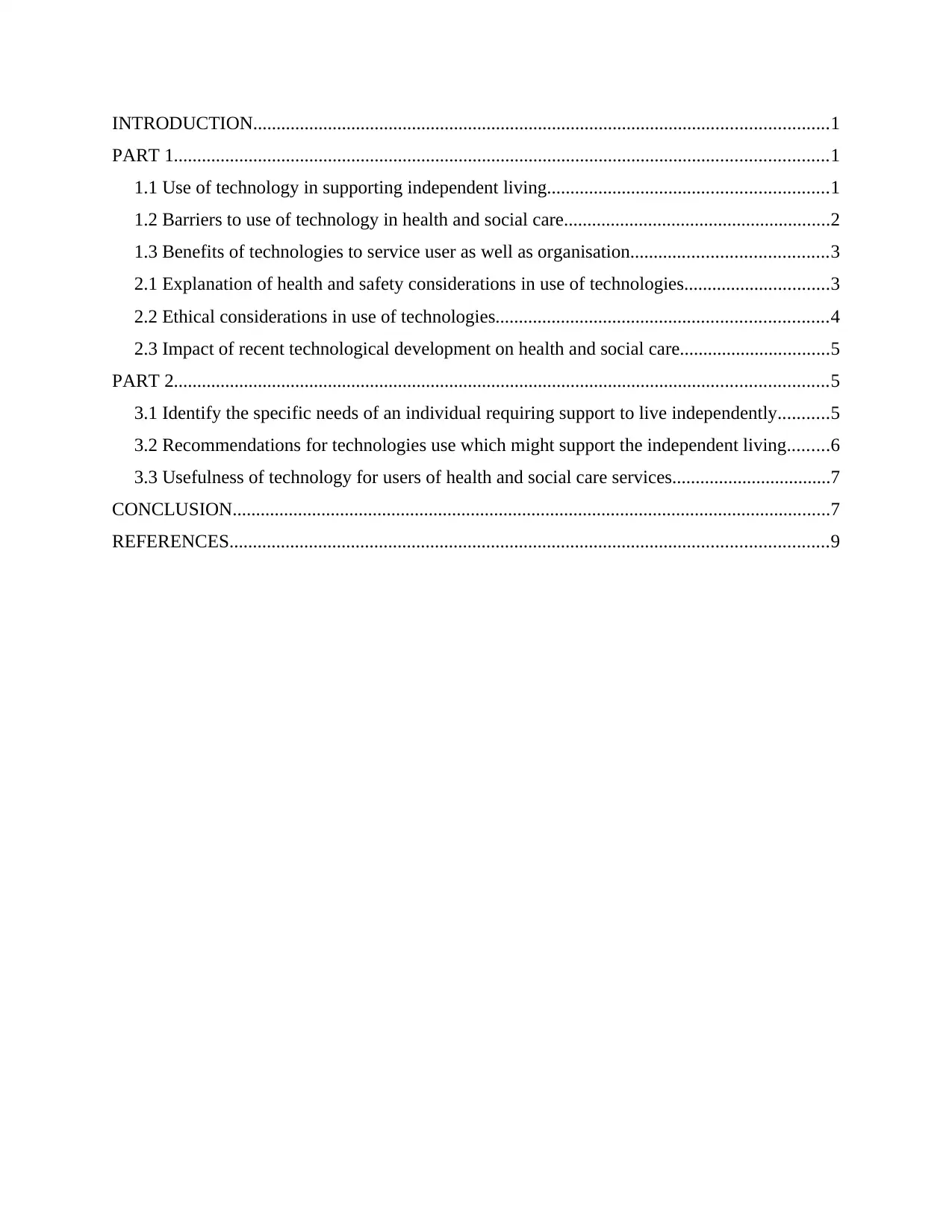
INTRODUCTION...........................................................................................................................1
PART 1............................................................................................................................................1
1.1 Use of technology in supporting independent living............................................................1
1.2 Barriers to use of technology in health and social care.........................................................2
1.3 Benefits of technologies to service user as well as organisation..........................................3
2.1 Explanation of health and safety considerations in use of technologies...............................3
2.2 Ethical considerations in use of technologies.......................................................................4
2.3 Impact of recent technological development on health and social care................................5
PART 2............................................................................................................................................5
3.1 Identify the specific needs of an individual requiring support to live independently...........5
3.2 Recommendations for technologies use which might support the independent living.........6
3.3 Usefulness of technology for users of health and social care services..................................7
CONCLUSION................................................................................................................................7
REFERENCES................................................................................................................................9
PART 1............................................................................................................................................1
1.1 Use of technology in supporting independent living............................................................1
1.2 Barriers to use of technology in health and social care.........................................................2
1.3 Benefits of technologies to service user as well as organisation..........................................3
2.1 Explanation of health and safety considerations in use of technologies...............................3
2.2 Ethical considerations in use of technologies.......................................................................4
2.3 Impact of recent technological development on health and social care................................5
PART 2............................................................................................................................................5
3.1 Identify the specific needs of an individual requiring support to live independently...........5
3.2 Recommendations for technologies use which might support the independent living.........6
3.3 Usefulness of technology for users of health and social care services..................................7
CONCLUSION................................................................................................................................7
REFERENCES................................................................................................................................9
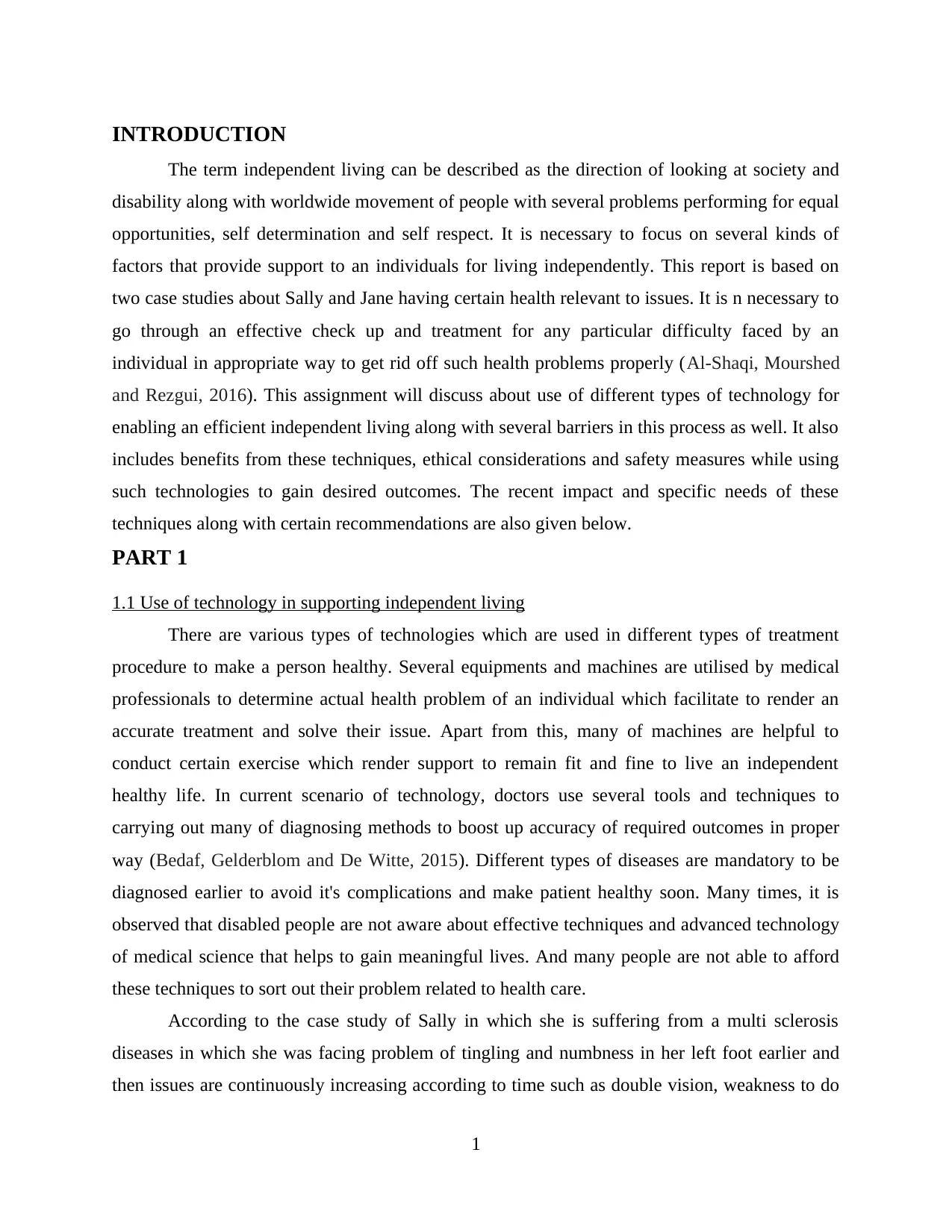
INTRODUCTION
The term independent living can be described as the direction of looking at society and
disability along with worldwide movement of people with several problems performing for equal
opportunities, self determination and self respect. It is necessary to focus on several kinds of
factors that provide support to an individuals for living independently. This report is based on
two case studies about Sally and Jane having certain health relevant to issues. It is n necessary to
go through an effective check up and treatment for any particular difficulty faced by an
individual in appropriate way to get rid off such health problems properly (Al-Shaqi, Mourshed
and Rezgui, 2016). This assignment will discuss about use of different types of technology for
enabling an efficient independent living along with several barriers in this process as well. It also
includes benefits from these techniques, ethical considerations and safety measures while using
such technologies to gain desired outcomes. The recent impact and specific needs of these
techniques along with certain recommendations are also given below.
PART 1
1.1 Use of technology in supporting independent living
There are various types of technologies which are used in different types of treatment
procedure to make a person healthy. Several equipments and machines are utilised by medical
professionals to determine actual health problem of an individual which facilitate to render an
accurate treatment and solve their issue. Apart from this, many of machines are helpful to
conduct certain exercise which render support to remain fit and fine to live an independent
healthy life. In current scenario of technology, doctors use several tools and techniques to
carrying out many of diagnosing methods to boost up accuracy of required outcomes in proper
way (Bedaf, Gelderblom and De Witte, 2015). Different types of diseases are mandatory to be
diagnosed earlier to avoid it's complications and make patient healthy soon. Many times, it is
observed that disabled people are not aware about effective techniques and advanced technology
of medical science that helps to gain meaningful lives. And many people are not able to afford
these techniques to sort out their problem related to health care.
According to the case study of Sally in which she is suffering from a multi sclerosis
diseases in which she was facing problem of tingling and numbness in her left foot earlier and
then issues are continuously increasing according to time such as double vision, weakness to do
1
The term independent living can be described as the direction of looking at society and
disability along with worldwide movement of people with several problems performing for equal
opportunities, self determination and self respect. It is necessary to focus on several kinds of
factors that provide support to an individuals for living independently. This report is based on
two case studies about Sally and Jane having certain health relevant to issues. It is n necessary to
go through an effective check up and treatment for any particular difficulty faced by an
individual in appropriate way to get rid off such health problems properly (Al-Shaqi, Mourshed
and Rezgui, 2016). This assignment will discuss about use of different types of technology for
enabling an efficient independent living along with several barriers in this process as well. It also
includes benefits from these techniques, ethical considerations and safety measures while using
such technologies to gain desired outcomes. The recent impact and specific needs of these
techniques along with certain recommendations are also given below.
PART 1
1.1 Use of technology in supporting independent living
There are various types of technologies which are used in different types of treatment
procedure to make a person healthy. Several equipments and machines are utilised by medical
professionals to determine actual health problem of an individual which facilitate to render an
accurate treatment and solve their issue. Apart from this, many of machines are helpful to
conduct certain exercise which render support to remain fit and fine to live an independent
healthy life. In current scenario of technology, doctors use several tools and techniques to
carrying out many of diagnosing methods to boost up accuracy of required outcomes in proper
way (Bedaf, Gelderblom and De Witte, 2015). Different types of diseases are mandatory to be
diagnosed earlier to avoid it's complications and make patient healthy soon. Many times, it is
observed that disabled people are not aware about effective techniques and advanced technology
of medical science that helps to gain meaningful lives. And many people are not able to afford
these techniques to sort out their problem related to health care.
According to the case study of Sally in which she is suffering from a multi sclerosis
diseases in which she was facing problem of tingling and numbness in her left foot earlier and
then issues are continuously increasing according to time such as double vision, weakness to do
1
⊘ This is a preview!⊘
Do you want full access?
Subscribe today to unlock all pages.

Trusted by 1+ million students worldwide
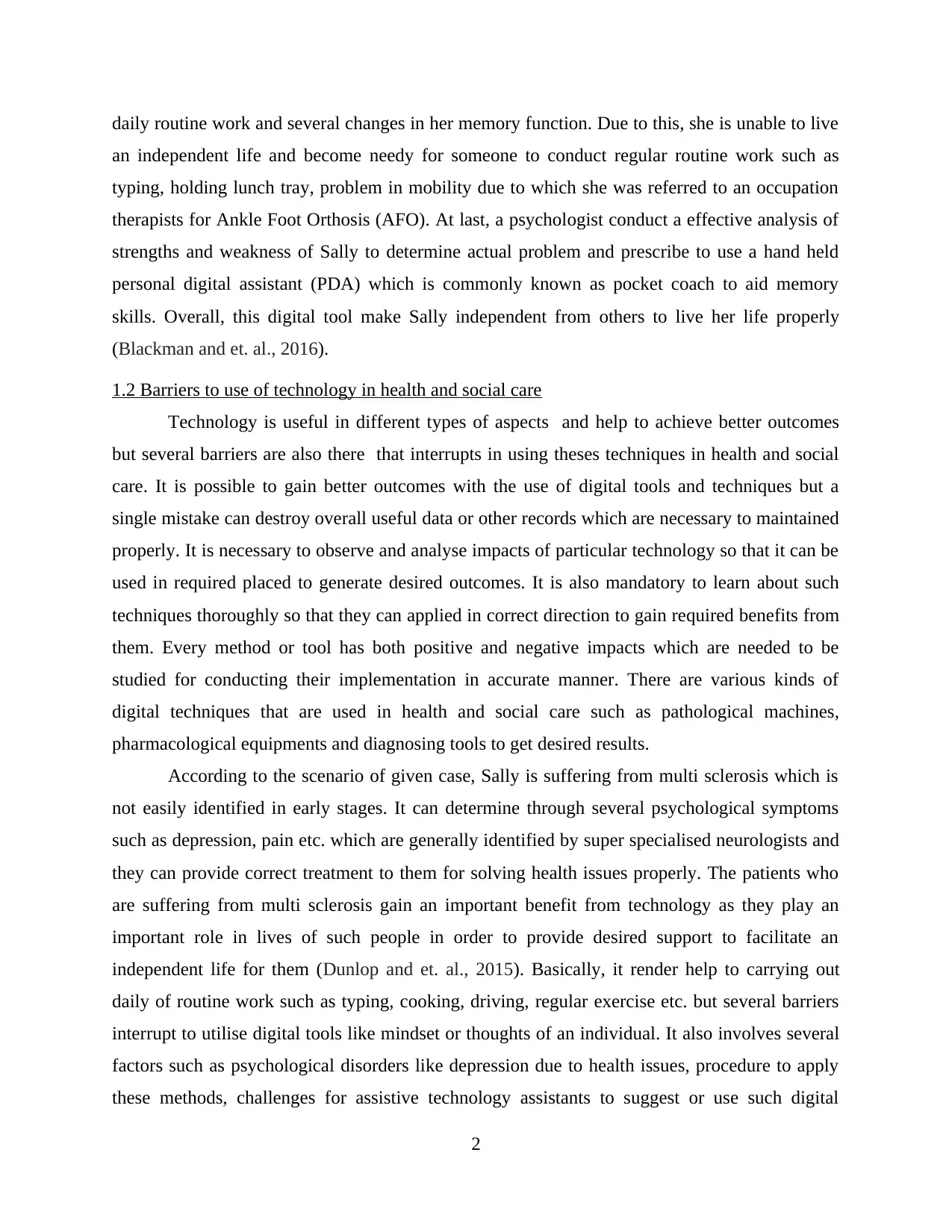
daily routine work and several changes in her memory function. Due to this, she is unable to live
an independent life and become needy for someone to conduct regular routine work such as
typing, holding lunch tray, problem in mobility due to which she was referred to an occupation
therapists for Ankle Foot Orthosis (AFO). At last, a psychologist conduct a effective analysis of
strengths and weakness of Sally to determine actual problem and prescribe to use a hand held
personal digital assistant (PDA) which is commonly known as pocket coach to aid memory
skills. Overall, this digital tool make Sally independent from others to live her life properly
(Blackman and et. al., 2016).
1.2 Barriers to use of technology in health and social care
Technology is useful in different types of aspects and help to achieve better outcomes
but several barriers are also there that interrupts in using theses techniques in health and social
care. It is possible to gain better outcomes with the use of digital tools and techniques but a
single mistake can destroy overall useful data or other records which are necessary to maintained
properly. It is necessary to observe and analyse impacts of particular technology so that it can be
used in required placed to generate desired outcomes. It is also mandatory to learn about such
techniques thoroughly so that they can applied in correct direction to gain required benefits from
them. Every method or tool has both positive and negative impacts which are needed to be
studied for conducting their implementation in accurate manner. There are various kinds of
digital techniques that are used in health and social care such as pathological machines,
pharmacological equipments and diagnosing tools to get desired results.
According to the scenario of given case, Sally is suffering from multi sclerosis which is
not easily identified in early stages. It can determine through several psychological symptoms
such as depression, pain etc. which are generally identified by super specialised neurologists and
they can provide correct treatment to them for solving health issues properly. The patients who
are suffering from multi sclerosis gain an important benefit from technology as they play an
important role in lives of such people in order to provide desired support to facilitate an
independent life for them (Dunlop and et. al., 2015). Basically, it render help to carrying out
daily of routine work such as typing, cooking, driving, regular exercise etc. but several barriers
interrupt to utilise digital tools like mindset or thoughts of an individual. It also involves several
factors such as psychological disorders like depression due to health issues, procedure to apply
these methods, challenges for assistive technology assistants to suggest or use such digital
2
an independent life and become needy for someone to conduct regular routine work such as
typing, holding lunch tray, problem in mobility due to which she was referred to an occupation
therapists for Ankle Foot Orthosis (AFO). At last, a psychologist conduct a effective analysis of
strengths and weakness of Sally to determine actual problem and prescribe to use a hand held
personal digital assistant (PDA) which is commonly known as pocket coach to aid memory
skills. Overall, this digital tool make Sally independent from others to live her life properly
(Blackman and et. al., 2016).
1.2 Barriers to use of technology in health and social care
Technology is useful in different types of aspects and help to achieve better outcomes
but several barriers are also there that interrupts in using theses techniques in health and social
care. It is possible to gain better outcomes with the use of digital tools and techniques but a
single mistake can destroy overall useful data or other records which are necessary to maintained
properly. It is necessary to observe and analyse impacts of particular technology so that it can be
used in required placed to generate desired outcomes. It is also mandatory to learn about such
techniques thoroughly so that they can applied in correct direction to gain required benefits from
them. Every method or tool has both positive and negative impacts which are needed to be
studied for conducting their implementation in accurate manner. There are various kinds of
digital techniques that are used in health and social care such as pathological machines,
pharmacological equipments and diagnosing tools to get desired results.
According to the scenario of given case, Sally is suffering from multi sclerosis which is
not easily identified in early stages. It can determine through several psychological symptoms
such as depression, pain etc. which are generally identified by super specialised neurologists and
they can provide correct treatment to them for solving health issues properly. The patients who
are suffering from multi sclerosis gain an important benefit from technology as they play an
important role in lives of such people in order to provide desired support to facilitate an
independent life for them (Dunlop and et. al., 2015). Basically, it render help to carrying out
daily of routine work such as typing, cooking, driving, regular exercise etc. but several barriers
interrupt to utilise digital tools like mindset or thoughts of an individual. It also involves several
factors such as psychological disorders like depression due to health issues, procedure to apply
these methods, challenges for assistive technology assistants to suggest or use such digital
2
Paraphrase This Document
Need a fresh take? Get an instant paraphrase of this document with our AI Paraphraser
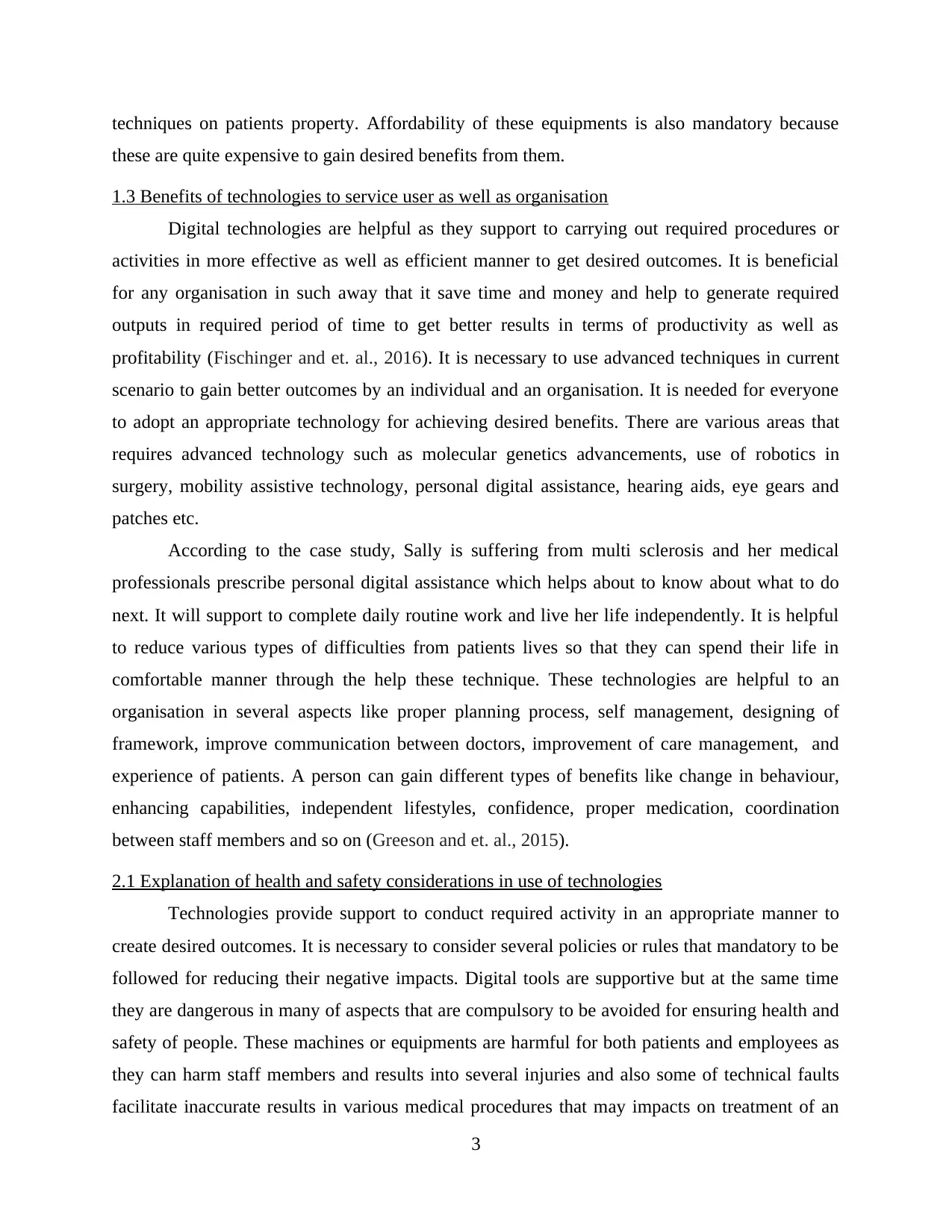
techniques on patients property. Affordability of these equipments is also mandatory because
these are quite expensive to gain desired benefits from them.
1.3 Benefits of technologies to service user as well as organisation
Digital technologies are helpful as they support to carrying out required procedures or
activities in more effective as well as efficient manner to get desired outcomes. It is beneficial
for any organisation in such away that it save time and money and help to generate required
outputs in required period of time to get better results in terms of productivity as well as
profitability (Fischinger and et. al., 2016). It is necessary to use advanced techniques in current
scenario to gain better outcomes by an individual and an organisation. It is needed for everyone
to adopt an appropriate technology for achieving desired benefits. There are various areas that
requires advanced technology such as molecular genetics advancements, use of robotics in
surgery, mobility assistive technology, personal digital assistance, hearing aids, eye gears and
patches etc.
According to the case study, Sally is suffering from multi sclerosis and her medical
professionals prescribe personal digital assistance which helps about to know about what to do
next. It will support to complete daily routine work and live her life independently. It is helpful
to reduce various types of difficulties from patients lives so that they can spend their life in
comfortable manner through the help these technique. These technologies are helpful to an
organisation in several aspects like proper planning process, self management, designing of
framework, improve communication between doctors, improvement of care management, and
experience of patients. A person can gain different types of benefits like change in behaviour,
enhancing capabilities, independent lifestyles, confidence, proper medication, coordination
between staff members and so on (Greeson and et. al., 2015).
2.1 Explanation of health and safety considerations in use of technologies
Technologies provide support to conduct required activity in an appropriate manner to
create desired outcomes. It is necessary to consider several policies or rules that mandatory to be
followed for reducing their negative impacts. Digital tools are supportive but at the same time
they are dangerous in many of aspects that are compulsory to be avoided for ensuring health and
safety of people. These machines or equipments are harmful for both patients and employees as
they can harm staff members and results into several injuries and also some of technical faults
facilitate inaccurate results in various medical procedures that may impacts on treatment of an
3
these are quite expensive to gain desired benefits from them.
1.3 Benefits of technologies to service user as well as organisation
Digital technologies are helpful as they support to carrying out required procedures or
activities in more effective as well as efficient manner to get desired outcomes. It is beneficial
for any organisation in such away that it save time and money and help to generate required
outputs in required period of time to get better results in terms of productivity as well as
profitability (Fischinger and et. al., 2016). It is necessary to use advanced techniques in current
scenario to gain better outcomes by an individual and an organisation. It is needed for everyone
to adopt an appropriate technology for achieving desired benefits. There are various areas that
requires advanced technology such as molecular genetics advancements, use of robotics in
surgery, mobility assistive technology, personal digital assistance, hearing aids, eye gears and
patches etc.
According to the case study, Sally is suffering from multi sclerosis and her medical
professionals prescribe personal digital assistance which helps about to know about what to do
next. It will support to complete daily routine work and live her life independently. It is helpful
to reduce various types of difficulties from patients lives so that they can spend their life in
comfortable manner through the help these technique. These technologies are helpful to an
organisation in several aspects like proper planning process, self management, designing of
framework, improve communication between doctors, improvement of care management, and
experience of patients. A person can gain different types of benefits like change in behaviour,
enhancing capabilities, independent lifestyles, confidence, proper medication, coordination
between staff members and so on (Greeson and et. al., 2015).
2.1 Explanation of health and safety considerations in use of technologies
Technologies provide support to conduct required activity in an appropriate manner to
create desired outcomes. It is necessary to consider several policies or rules that mandatory to be
followed for reducing their negative impacts. Digital tools are supportive but at the same time
they are dangerous in many of aspects that are compulsory to be avoided for ensuring health and
safety of people. These machines or equipments are harmful for both patients and employees as
they can harm staff members and results into several injuries and also some of technical faults
facilitate inaccurate results in various medical procedures that may impacts on treatment of an
3
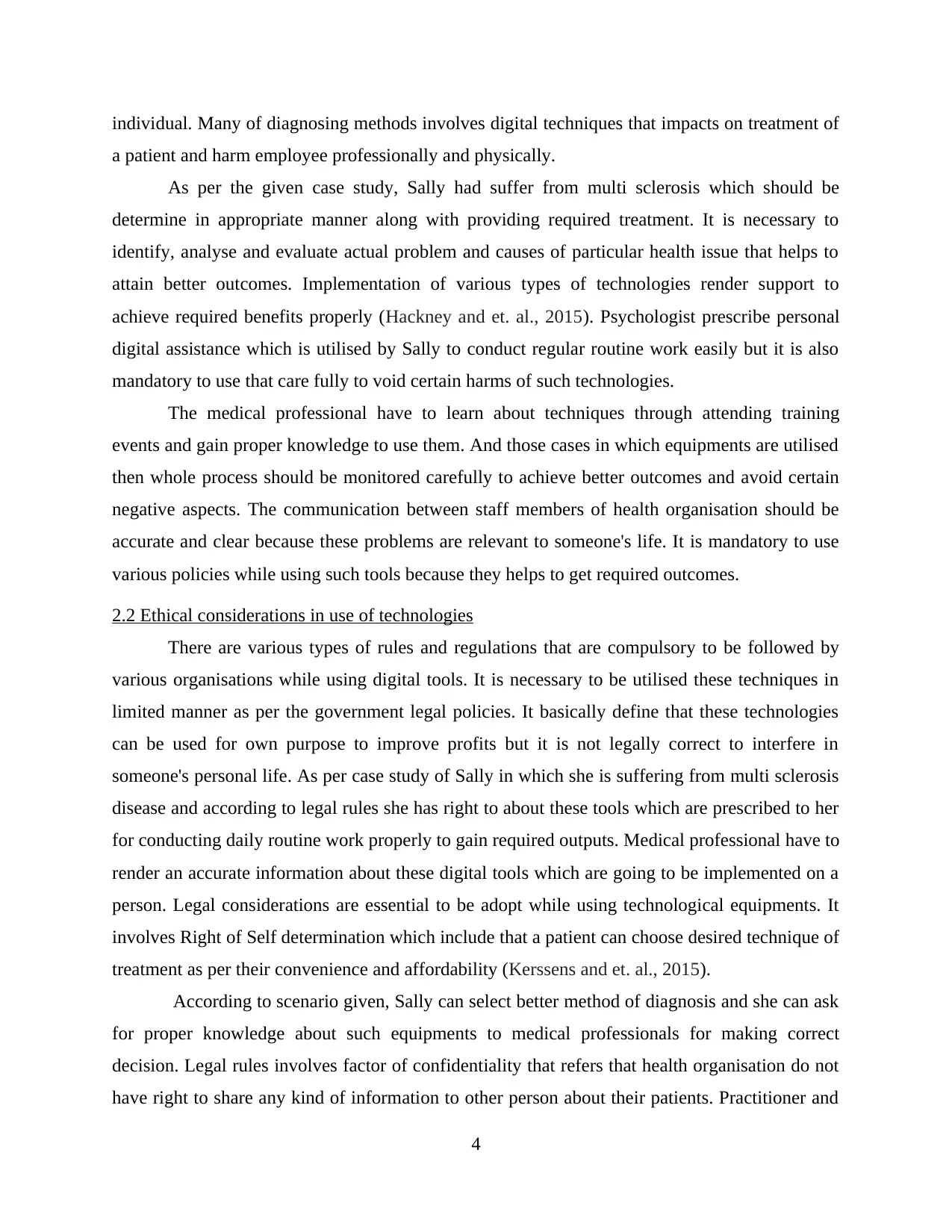
individual. Many of diagnosing methods involves digital techniques that impacts on treatment of
a patient and harm employee professionally and physically.
As per the given case study, Sally had suffer from multi sclerosis which should be
determine in appropriate manner along with providing required treatment. It is necessary to
identify, analyse and evaluate actual problem and causes of particular health issue that helps to
attain better outcomes. Implementation of various types of technologies render support to
achieve required benefits properly (Hackney and et. al., 2015). Psychologist prescribe personal
digital assistance which is utilised by Sally to conduct regular routine work easily but it is also
mandatory to use that care fully to void certain harms of such technologies.
The medical professional have to learn about techniques through attending training
events and gain proper knowledge to use them. And those cases in which equipments are utilised
then whole process should be monitored carefully to achieve better outcomes and avoid certain
negative aspects. The communication between staff members of health organisation should be
accurate and clear because these problems are relevant to someone's life. It is mandatory to use
various policies while using such tools because they helps to get required outcomes.
2.2 Ethical considerations in use of technologies
There are various types of rules and regulations that are compulsory to be followed by
various organisations while using digital tools. It is necessary to be utilised these techniques in
limited manner as per the government legal policies. It basically define that these technologies
can be used for own purpose to improve profits but it is not legally correct to interfere in
someone's personal life. As per case study of Sally in which she is suffering from multi sclerosis
disease and according to legal rules she has right to about these tools which are prescribed to her
for conducting daily routine work properly to gain required outputs. Medical professional have to
render an accurate information about these digital tools which are going to be implemented on a
person. Legal considerations are essential to be adopt while using technological equipments. It
involves Right of Self determination which include that a patient can choose desired technique of
treatment as per their convenience and affordability (Kerssens and et. al., 2015).
According to scenario given, Sally can select better method of diagnosis and she can ask
for proper knowledge about such equipments to medical professionals for making correct
decision. Legal rules involves factor of confidentiality that refers that health organisation do not
have right to share any kind of information to other person about their patients. Practitioner and
4
a patient and harm employee professionally and physically.
As per the given case study, Sally had suffer from multi sclerosis which should be
determine in appropriate manner along with providing required treatment. It is necessary to
identify, analyse and evaluate actual problem and causes of particular health issue that helps to
attain better outcomes. Implementation of various types of technologies render support to
achieve required benefits properly (Hackney and et. al., 2015). Psychologist prescribe personal
digital assistance which is utilised by Sally to conduct regular routine work easily but it is also
mandatory to use that care fully to void certain harms of such technologies.
The medical professional have to learn about techniques through attending training
events and gain proper knowledge to use them. And those cases in which equipments are utilised
then whole process should be monitored carefully to achieve better outcomes and avoid certain
negative aspects. The communication between staff members of health organisation should be
accurate and clear because these problems are relevant to someone's life. It is mandatory to use
various policies while using such tools because they helps to get required outcomes.
2.2 Ethical considerations in use of technologies
There are various types of rules and regulations that are compulsory to be followed by
various organisations while using digital tools. It is necessary to be utilised these techniques in
limited manner as per the government legal policies. It basically define that these technologies
can be used for own purpose to improve profits but it is not legally correct to interfere in
someone's personal life. As per case study of Sally in which she is suffering from multi sclerosis
disease and according to legal rules she has right to about these tools which are prescribed to her
for conducting daily routine work properly to gain required outputs. Medical professional have to
render an accurate information about these digital tools which are going to be implemented on a
person. Legal considerations are essential to be adopt while using technological equipments. It
involves Right of Self determination which include that a patient can choose desired technique of
treatment as per their convenience and affordability (Kerssens and et. al., 2015).
According to scenario given, Sally can select better method of diagnosis and she can ask
for proper knowledge about such equipments to medical professionals for making correct
decision. Legal rules involves factor of confidentiality that refers that health organisation do not
have right to share any kind of information to other person about their patients. Practitioner and
4
⊘ This is a preview!⊘
Do you want full access?
Subscribe today to unlock all pages.

Trusted by 1+ million students worldwide
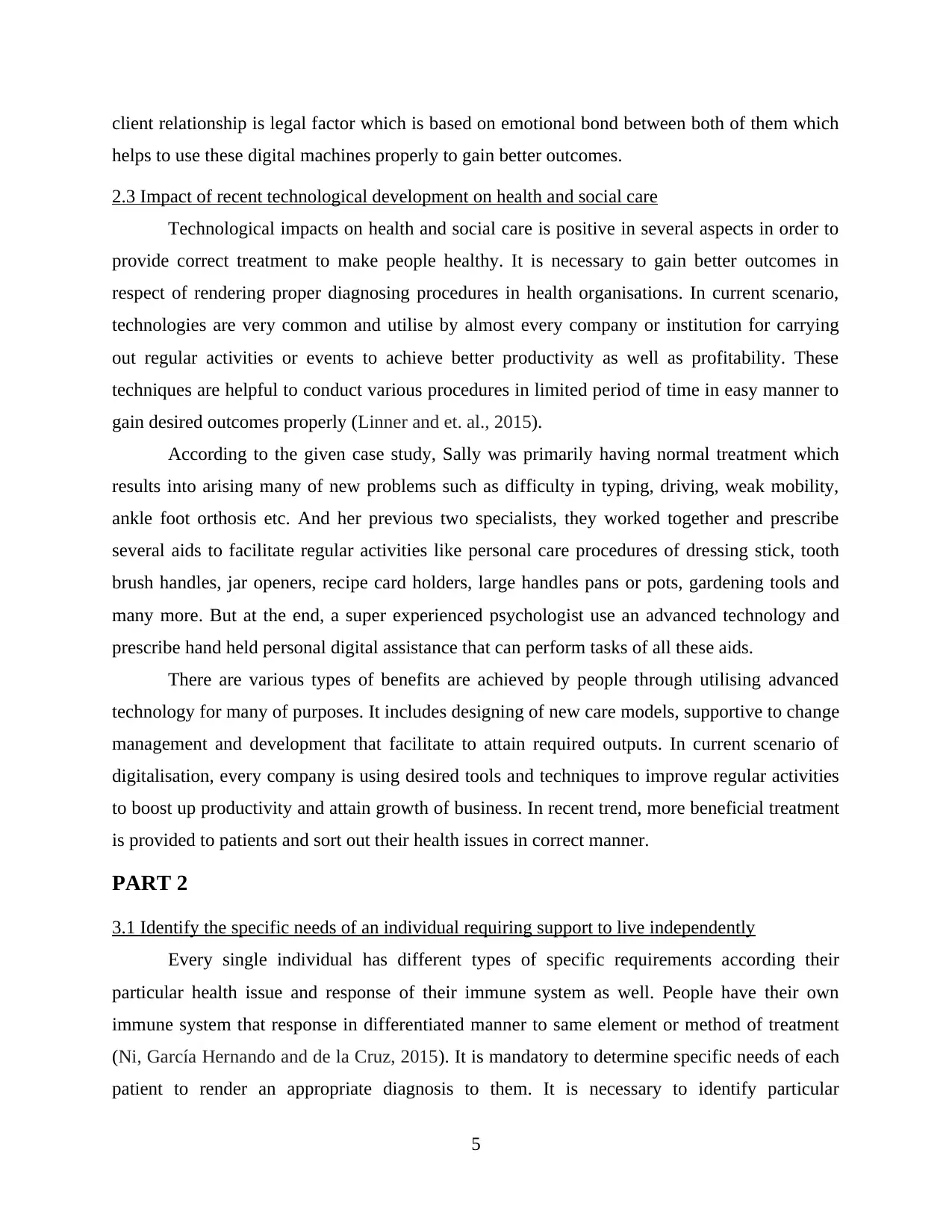
client relationship is legal factor which is based on emotional bond between both of them which
helps to use these digital machines properly to gain better outcomes.
2.3 Impact of recent technological development on health and social care
Technological impacts on health and social care is positive in several aspects in order to
provide correct treatment to make people healthy. It is necessary to gain better outcomes in
respect of rendering proper diagnosing procedures in health organisations. In current scenario,
technologies are very common and utilise by almost every company or institution for carrying
out regular activities or events to achieve better productivity as well as profitability. These
techniques are helpful to conduct various procedures in limited period of time in easy manner to
gain desired outcomes properly (Linner and et. al., 2015).
According to the given case study, Sally was primarily having normal treatment which
results into arising many of new problems such as difficulty in typing, driving, weak mobility,
ankle foot orthosis etc. And her previous two specialists, they worked together and prescribe
several aids to facilitate regular activities like personal care procedures of dressing stick, tooth
brush handles, jar openers, recipe card holders, large handles pans or pots, gardening tools and
many more. But at the end, a super experienced psychologist use an advanced technology and
prescribe hand held personal digital assistance that can perform tasks of all these aids.
There are various types of benefits are achieved by people through utilising advanced
technology for many of purposes. It includes designing of new care models, supportive to change
management and development that facilitate to attain required outputs. In current scenario of
digitalisation, every company is using desired tools and techniques to improve regular activities
to boost up productivity and attain growth of business. In recent trend, more beneficial treatment
is provided to patients and sort out their health issues in correct manner.
PART 2
3.1 Identify the specific needs of an individual requiring support to live independently
Every single individual has different types of specific requirements according their
particular health issue and response of their immune system as well. People have their own
immune system that response in differentiated manner to same element or method of treatment
(Ni, García Hernando and de la Cruz, 2015). It is mandatory to determine specific needs of each
patient to render an appropriate diagnosis to them. It is necessary to identify particular
5
helps to use these digital machines properly to gain better outcomes.
2.3 Impact of recent technological development on health and social care
Technological impacts on health and social care is positive in several aspects in order to
provide correct treatment to make people healthy. It is necessary to gain better outcomes in
respect of rendering proper diagnosing procedures in health organisations. In current scenario,
technologies are very common and utilise by almost every company or institution for carrying
out regular activities or events to achieve better productivity as well as profitability. These
techniques are helpful to conduct various procedures in limited period of time in easy manner to
gain desired outcomes properly (Linner and et. al., 2015).
According to the given case study, Sally was primarily having normal treatment which
results into arising many of new problems such as difficulty in typing, driving, weak mobility,
ankle foot orthosis etc. And her previous two specialists, they worked together and prescribe
several aids to facilitate regular activities like personal care procedures of dressing stick, tooth
brush handles, jar openers, recipe card holders, large handles pans or pots, gardening tools and
many more. But at the end, a super experienced psychologist use an advanced technology and
prescribe hand held personal digital assistance that can perform tasks of all these aids.
There are various types of benefits are achieved by people through utilising advanced
technology for many of purposes. It includes designing of new care models, supportive to change
management and development that facilitate to attain required outputs. In current scenario of
digitalisation, every company is using desired tools and techniques to improve regular activities
to boost up productivity and attain growth of business. In recent trend, more beneficial treatment
is provided to patients and sort out their health issues in correct manner.
PART 2
3.1 Identify the specific needs of an individual requiring support to live independently
Every single individual has different types of specific requirements according their
particular health issue and response of their immune system as well. People have their own
immune system that response in differentiated manner to same element or method of treatment
(Ni, García Hernando and de la Cruz, 2015). It is mandatory to determine specific needs of each
patient to render an appropriate diagnosis to them. It is necessary to identify particular
5
Paraphrase This Document
Need a fresh take? Get an instant paraphrase of this document with our AI Paraphraser
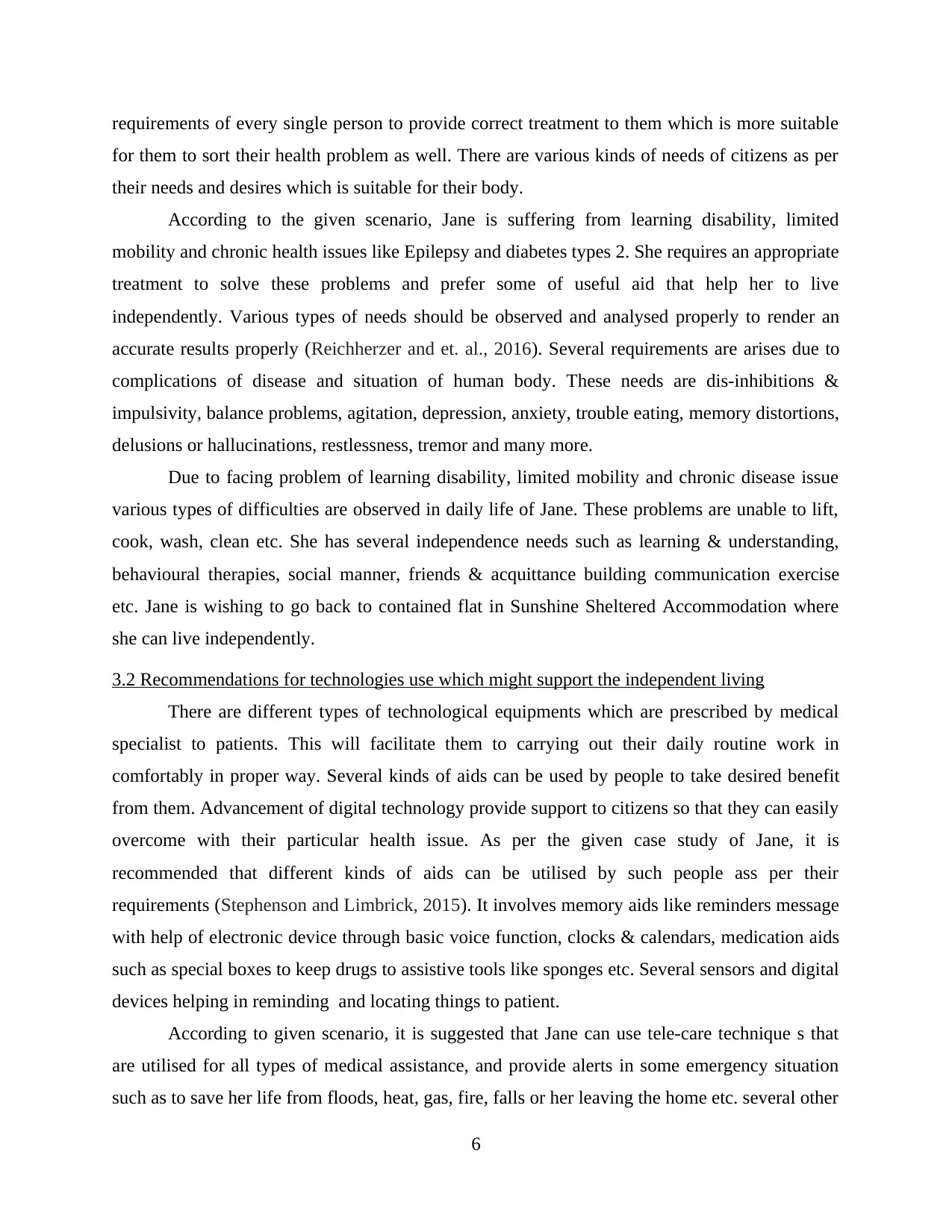
requirements of every single person to provide correct treatment to them which is more suitable
for them to sort their health problem as well. There are various kinds of needs of citizens as per
their needs and desires which is suitable for their body.
According to the given scenario, Jane is suffering from learning disability, limited
mobility and chronic health issues like Epilepsy and diabetes types 2. She requires an appropriate
treatment to solve these problems and prefer some of useful aid that help her to live
independently. Various types of needs should be observed and analysed properly to render an
accurate results properly (Reichherzer and et. al., 2016). Several requirements are arises due to
complications of disease and situation of human body. These needs are dis-inhibitions &
impulsivity, balance problems, agitation, depression, anxiety, trouble eating, memory distortions,
delusions or hallucinations, restlessness, tremor and many more.
Due to facing problem of learning disability, limited mobility and chronic disease issue
various types of difficulties are observed in daily life of Jane. These problems are unable to lift,
cook, wash, clean etc. She has several independence needs such as learning & understanding,
behavioural therapies, social manner, friends & acquittance building communication exercise
etc. Jane is wishing to go back to contained flat in Sunshine Sheltered Accommodation where
she can live independently.
3.2 Recommendations for technologies use which might support the independent living
There are different types of technological equipments which are prescribed by medical
specialist to patients. This will facilitate them to carrying out their daily routine work in
comfortably in proper way. Several kinds of aids can be used by people to take desired benefit
from them. Advancement of digital technology provide support to citizens so that they can easily
overcome with their particular health issue. As per the given case study of Jane, it is
recommended that different kinds of aids can be utilised by such people ass per their
requirements (Stephenson and Limbrick, 2015). It involves memory aids like reminders message
with help of electronic device through basic voice function, clocks & calendars, medication aids
such as special boxes to keep drugs to assistive tools like sponges etc. Several sensors and digital
devices helping in reminding and locating things to patient.
According to given scenario, it is suggested that Jane can use tele-care technique s that
are utilised for all types of medical assistance, and provide alerts in some emergency situation
such as to save her life from floods, heat, gas, fire, falls or her leaving the home etc. several other
6
for them to sort their health problem as well. There are various kinds of needs of citizens as per
their needs and desires which is suitable for their body.
According to the given scenario, Jane is suffering from learning disability, limited
mobility and chronic health issues like Epilepsy and diabetes types 2. She requires an appropriate
treatment to solve these problems and prefer some of useful aid that help her to live
independently. Various types of needs should be observed and analysed properly to render an
accurate results properly (Reichherzer and et. al., 2016). Several requirements are arises due to
complications of disease and situation of human body. These needs are dis-inhibitions &
impulsivity, balance problems, agitation, depression, anxiety, trouble eating, memory distortions,
delusions or hallucinations, restlessness, tremor and many more.
Due to facing problem of learning disability, limited mobility and chronic disease issue
various types of difficulties are observed in daily life of Jane. These problems are unable to lift,
cook, wash, clean etc. She has several independence needs such as learning & understanding,
behavioural therapies, social manner, friends & acquittance building communication exercise
etc. Jane is wishing to go back to contained flat in Sunshine Sheltered Accommodation where
she can live independently.
3.2 Recommendations for technologies use which might support the independent living
There are different types of technological equipments which are prescribed by medical
specialist to patients. This will facilitate them to carrying out their daily routine work in
comfortably in proper way. Several kinds of aids can be used by people to take desired benefit
from them. Advancement of digital technology provide support to citizens so that they can easily
overcome with their particular health issue. As per the given case study of Jane, it is
recommended that different kinds of aids can be utilised by such people ass per their
requirements (Stephenson and Limbrick, 2015). It involves memory aids like reminders message
with help of electronic device through basic voice function, clocks & calendars, medication aids
such as special boxes to keep drugs to assistive tools like sponges etc. Several sensors and digital
devices helping in reminding and locating things to patient.
According to given scenario, it is suggested that Jane can use tele-care technique s that
are utilised for all types of medical assistance, and provide alerts in some emergency situation
such as to save her life from floods, heat, gas, fire, falls or her leaving the home etc. several other
6
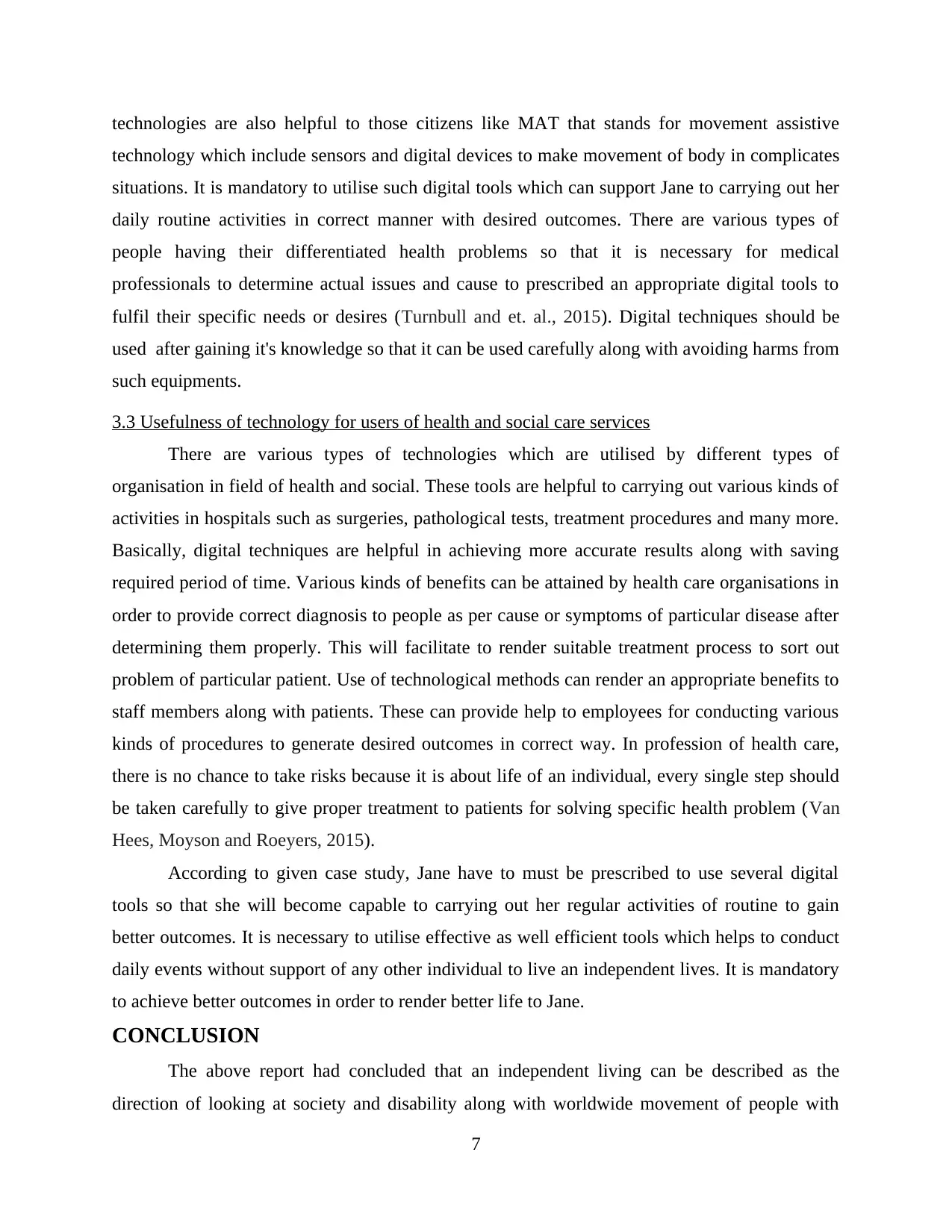
technologies are also helpful to those citizens like MAT that stands for movement assistive
technology which include sensors and digital devices to make movement of body in complicates
situations. It is mandatory to utilise such digital tools which can support Jane to carrying out her
daily routine activities in correct manner with desired outcomes. There are various types of
people having their differentiated health problems so that it is necessary for medical
professionals to determine actual issues and cause to prescribed an appropriate digital tools to
fulfil their specific needs or desires (Turnbull and et. al., 2015). Digital techniques should be
used after gaining it's knowledge so that it can be used carefully along with avoiding harms from
such equipments.
3.3 Usefulness of technology for users of health and social care services
There are various types of technologies which are utilised by different types of
organisation in field of health and social. These tools are helpful to carrying out various kinds of
activities in hospitals such as surgeries, pathological tests, treatment procedures and many more.
Basically, digital techniques are helpful in achieving more accurate results along with saving
required period of time. Various kinds of benefits can be attained by health care organisations in
order to provide correct diagnosis to people as per cause or symptoms of particular disease after
determining them properly. This will facilitate to render suitable treatment process to sort out
problem of particular patient. Use of technological methods can render an appropriate benefits to
staff members along with patients. These can provide help to employees for conducting various
kinds of procedures to generate desired outcomes in correct way. In profession of health care,
there is no chance to take risks because it is about life of an individual, every single step should
be taken carefully to give proper treatment to patients for solving specific health problem (Van
Hees, Moyson and Roeyers, 2015).
According to given case study, Jane have to must be prescribed to use several digital
tools so that she will become capable to carrying out her regular activities of routine to gain
better outcomes. It is necessary to utilise effective as well efficient tools which helps to conduct
daily events without support of any other individual to live an independent lives. It is mandatory
to achieve better outcomes in order to render better life to Jane.
CONCLUSION
The above report had concluded that an independent living can be described as the
direction of looking at society and disability along with worldwide movement of people with
7
technology which include sensors and digital devices to make movement of body in complicates
situations. It is mandatory to utilise such digital tools which can support Jane to carrying out her
daily routine activities in correct manner with desired outcomes. There are various types of
people having their differentiated health problems so that it is necessary for medical
professionals to determine actual issues and cause to prescribed an appropriate digital tools to
fulfil their specific needs or desires (Turnbull and et. al., 2015). Digital techniques should be
used after gaining it's knowledge so that it can be used carefully along with avoiding harms from
such equipments.
3.3 Usefulness of technology for users of health and social care services
There are various types of technologies which are utilised by different types of
organisation in field of health and social. These tools are helpful to carrying out various kinds of
activities in hospitals such as surgeries, pathological tests, treatment procedures and many more.
Basically, digital techniques are helpful in achieving more accurate results along with saving
required period of time. Various kinds of benefits can be attained by health care organisations in
order to provide correct diagnosis to people as per cause or symptoms of particular disease after
determining them properly. This will facilitate to render suitable treatment process to sort out
problem of particular patient. Use of technological methods can render an appropriate benefits to
staff members along with patients. These can provide help to employees for conducting various
kinds of procedures to generate desired outcomes in correct way. In profession of health care,
there is no chance to take risks because it is about life of an individual, every single step should
be taken carefully to give proper treatment to patients for solving specific health problem (Van
Hees, Moyson and Roeyers, 2015).
According to given case study, Jane have to must be prescribed to use several digital
tools so that she will become capable to carrying out her regular activities of routine to gain
better outcomes. It is necessary to utilise effective as well efficient tools which helps to conduct
daily events without support of any other individual to live an independent lives. It is mandatory
to achieve better outcomes in order to render better life to Jane.
CONCLUSION
The above report had concluded that an independent living can be described as the
direction of looking at society and disability along with worldwide movement of people with
7
⊘ This is a preview!⊘
Do you want full access?
Subscribe today to unlock all pages.

Trusted by 1+ million students worldwide
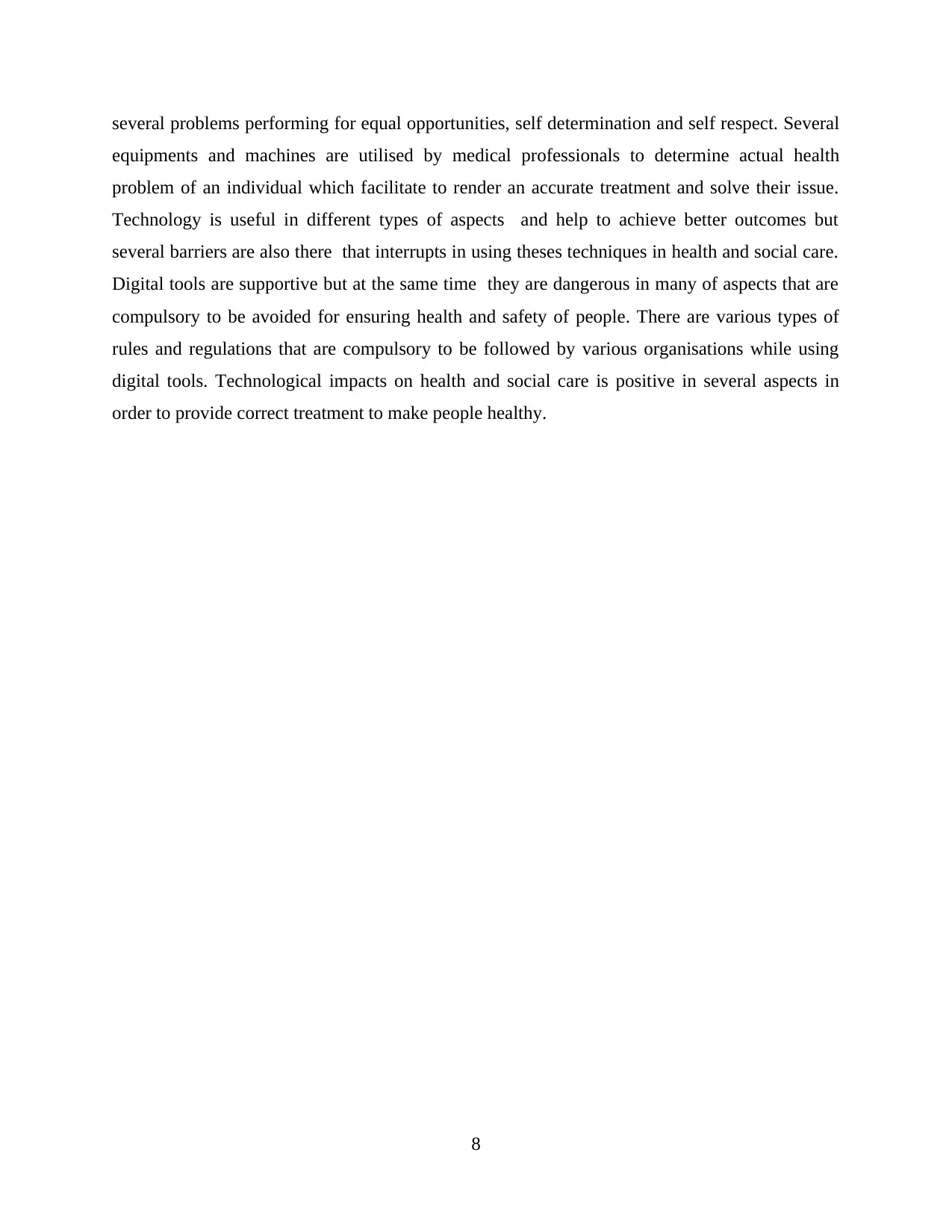
several problems performing for equal opportunities, self determination and self respect. Several
equipments and machines are utilised by medical professionals to determine actual health
problem of an individual which facilitate to render an accurate treatment and solve their issue.
Technology is useful in different types of aspects and help to achieve better outcomes but
several barriers are also there that interrupts in using theses techniques in health and social care.
Digital tools are supportive but at the same time they are dangerous in many of aspects that are
compulsory to be avoided for ensuring health and safety of people. There are various types of
rules and regulations that are compulsory to be followed by various organisations while using
digital tools. Technological impacts on health and social care is positive in several aspects in
order to provide correct treatment to make people healthy.
8
equipments and machines are utilised by medical professionals to determine actual health
problem of an individual which facilitate to render an accurate treatment and solve their issue.
Technology is useful in different types of aspects and help to achieve better outcomes but
several barriers are also there that interrupts in using theses techniques in health and social care.
Digital tools are supportive but at the same time they are dangerous in many of aspects that are
compulsory to be avoided for ensuring health and safety of people. There are various types of
rules and regulations that are compulsory to be followed by various organisations while using
digital tools. Technological impacts on health and social care is positive in several aspects in
order to provide correct treatment to make people healthy.
8
Paraphrase This Document
Need a fresh take? Get an instant paraphrase of this document with our AI Paraphraser
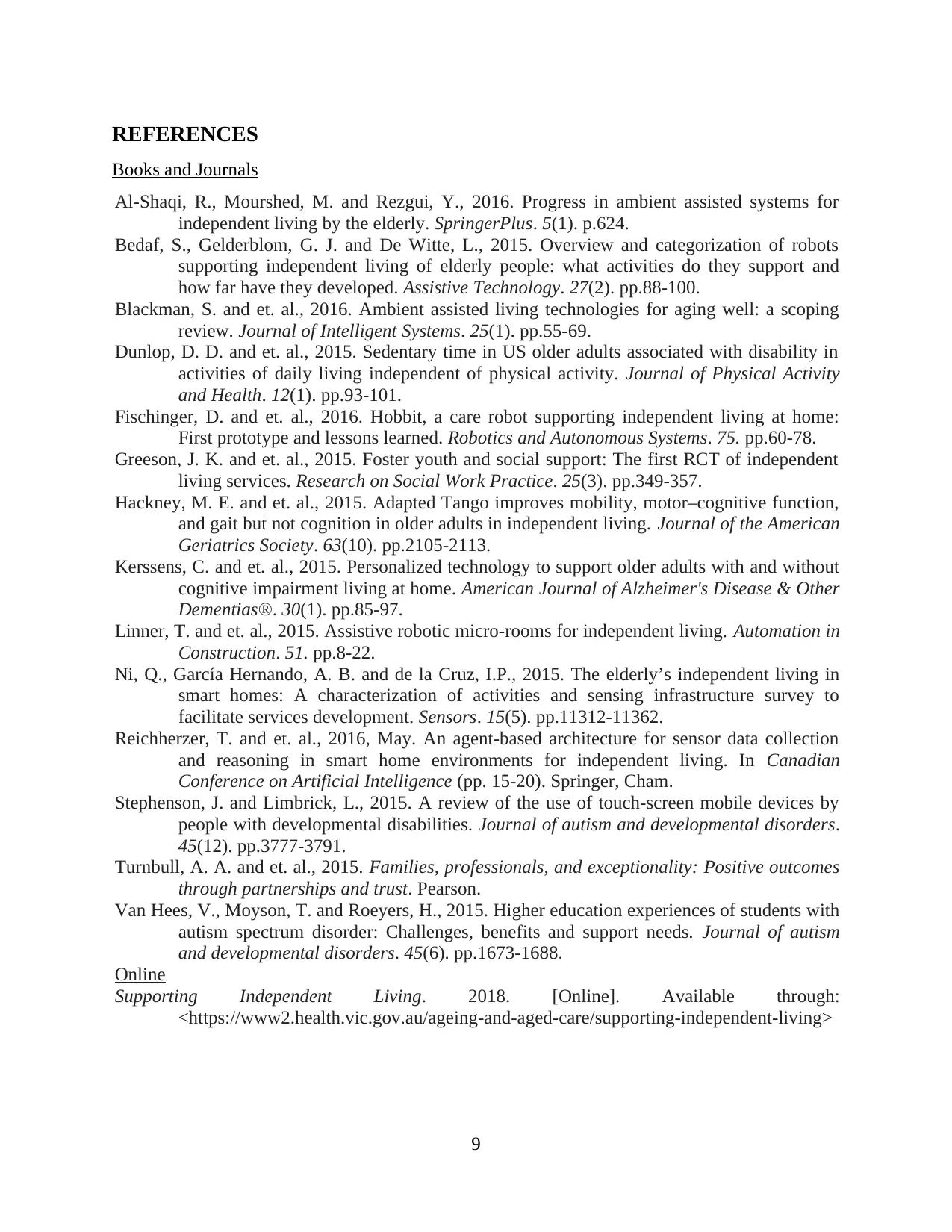
REFERENCES
Books and Journals
Al-Shaqi, R., Mourshed, M. and Rezgui, Y., 2016. Progress in ambient assisted systems for
independent living by the elderly. SpringerPlus. 5(1). p.624.
Bedaf, S., Gelderblom, G. J. and De Witte, L., 2015. Overview and categorization of robots
supporting independent living of elderly people: what activities do they support and
how far have they developed. Assistive Technology. 27(2). pp.88-100.
Blackman, S. and et. al., 2016. Ambient assisted living technologies for aging well: a scoping
review. Journal of Intelligent Systems. 25(1). pp.55-69.
Dunlop, D. D. and et. al., 2015. Sedentary time in US older adults associated with disability in
activities of daily living independent of physical activity. Journal of Physical Activity
and Health. 12(1). pp.93-101.
Fischinger, D. and et. al., 2016. Hobbit, a care robot supporting independent living at home:
First prototype and lessons learned. Robotics and Autonomous Systems. 75. pp.60-78.
Greeson, J. K. and et. al., 2015. Foster youth and social support: The first RCT of independent
living services. Research on Social Work Practice. 25(3). pp.349-357.
Hackney, M. E. and et. al., 2015. Adapted Tango improves mobility, motor–cognitive function,
and gait but not cognition in older adults in independent living. Journal of the American
Geriatrics Society. 63(10). pp.2105-2113.
Kerssens, C. and et. al., 2015. Personalized technology to support older adults with and without
cognitive impairment living at home. American Journal of Alzheimer's Disease & Other
Dementias®. 30(1). pp.85-97.
Linner, T. and et. al., 2015. Assistive robotic micro-rooms for independent living. Automation in
Construction. 51. pp.8-22.
Ni, Q., García Hernando, A. B. and de la Cruz, I.P., 2015. The elderly’s independent living in
smart homes: A characterization of activities and sensing infrastructure survey to
facilitate services development. Sensors. 15(5). pp.11312-11362.
Reichherzer, T. and et. al., 2016, May. An agent-based architecture for sensor data collection
and reasoning in smart home environments for independent living. In Canadian
Conference on Artificial Intelligence (pp. 15-20). Springer, Cham.
Stephenson, J. and Limbrick, L., 2015. A review of the use of touch-screen mobile devices by
people with developmental disabilities. Journal of autism and developmental disorders.
45(12). pp.3777-3791.
Turnbull, A. A. and et. al., 2015. Families, professionals, and exceptionality: Positive outcomes
through partnerships and trust. Pearson.
Van Hees, V., Moyson, T. and Roeyers, H., 2015. Higher education experiences of students with
autism spectrum disorder: Challenges, benefits and support needs. Journal of autism
and developmental disorders. 45(6). pp.1673-1688.
Online
Supporting Independent Living. 2018. [Online]. Available through:
<https://www2.health.vic.gov.au/ageing-and-aged-care/supporting-independent-living>
9
Books and Journals
Al-Shaqi, R., Mourshed, M. and Rezgui, Y., 2016. Progress in ambient assisted systems for
independent living by the elderly. SpringerPlus. 5(1). p.624.
Bedaf, S., Gelderblom, G. J. and De Witte, L., 2015. Overview and categorization of robots
supporting independent living of elderly people: what activities do they support and
how far have they developed. Assistive Technology. 27(2). pp.88-100.
Blackman, S. and et. al., 2016. Ambient assisted living technologies for aging well: a scoping
review. Journal of Intelligent Systems. 25(1). pp.55-69.
Dunlop, D. D. and et. al., 2015. Sedentary time in US older adults associated with disability in
activities of daily living independent of physical activity. Journal of Physical Activity
and Health. 12(1). pp.93-101.
Fischinger, D. and et. al., 2016. Hobbit, a care robot supporting independent living at home:
First prototype and lessons learned. Robotics and Autonomous Systems. 75. pp.60-78.
Greeson, J. K. and et. al., 2015. Foster youth and social support: The first RCT of independent
living services. Research on Social Work Practice. 25(3). pp.349-357.
Hackney, M. E. and et. al., 2015. Adapted Tango improves mobility, motor–cognitive function,
and gait but not cognition in older adults in independent living. Journal of the American
Geriatrics Society. 63(10). pp.2105-2113.
Kerssens, C. and et. al., 2015. Personalized technology to support older adults with and without
cognitive impairment living at home. American Journal of Alzheimer's Disease & Other
Dementias®. 30(1). pp.85-97.
Linner, T. and et. al., 2015. Assistive robotic micro-rooms for independent living. Automation in
Construction. 51. pp.8-22.
Ni, Q., García Hernando, A. B. and de la Cruz, I.P., 2015. The elderly’s independent living in
smart homes: A characterization of activities and sensing infrastructure survey to
facilitate services development. Sensors. 15(5). pp.11312-11362.
Reichherzer, T. and et. al., 2016, May. An agent-based architecture for sensor data collection
and reasoning in smart home environments for independent living. In Canadian
Conference on Artificial Intelligence (pp. 15-20). Springer, Cham.
Stephenson, J. and Limbrick, L., 2015. A review of the use of touch-screen mobile devices by
people with developmental disabilities. Journal of autism and developmental disorders.
45(12). pp.3777-3791.
Turnbull, A. A. and et. al., 2015. Families, professionals, and exceptionality: Positive outcomes
through partnerships and trust. Pearson.
Van Hees, V., Moyson, T. and Roeyers, H., 2015. Higher education experiences of students with
autism spectrum disorder: Challenges, benefits and support needs. Journal of autism
and developmental disorders. 45(6). pp.1673-1688.
Online
Supporting Independent Living. 2018. [Online]. Available through:
<https://www2.health.vic.gov.au/ageing-and-aged-care/supporting-independent-living>
9
1 out of 11
Related Documents
Your All-in-One AI-Powered Toolkit for Academic Success.
+13062052269
info@desklib.com
Available 24*7 on WhatsApp / Email
![[object Object]](/_next/static/media/star-bottom.7253800d.svg)
Unlock your academic potential
Copyright © 2020–2025 A2Z Services. All Rights Reserved. Developed and managed by ZUCOL.





